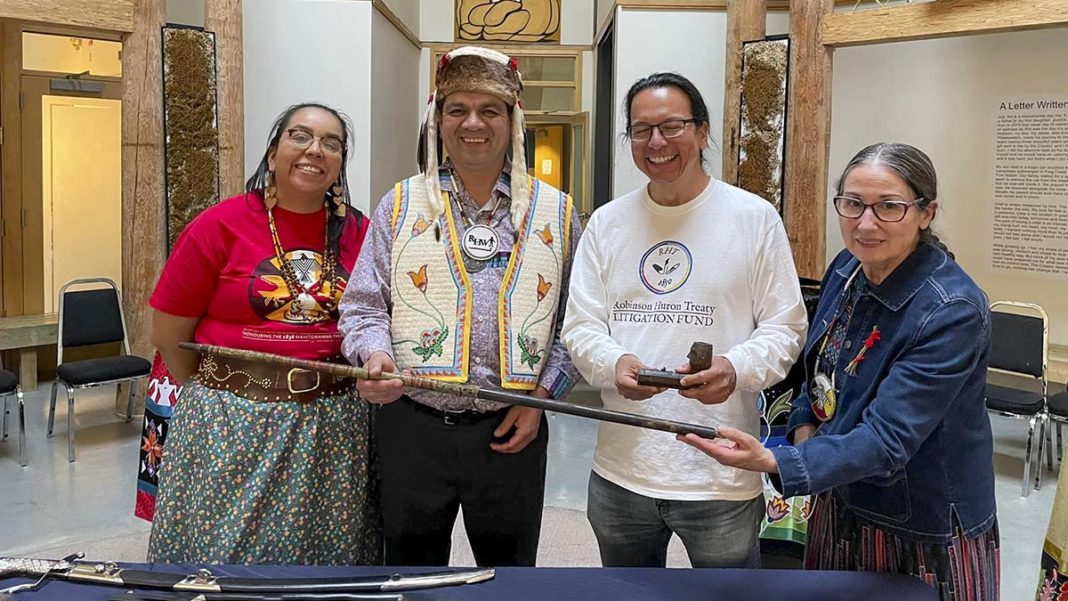M’CHIGEENG—An emotional homecoming took place at the Ojibwe Cultural Foundation (OCF) in M’Chigeeng recently as the Anishinaabe of Mnidoo Mnising welcomed home an important historical artifact, the Bond Head pipe, most likely presented to Lieutenant Governor of Upper Canada Sir Francis Bond Head in 1836 during a treaty gift ceremony held at Manitowaning. The peace pipe paid witness to one of the most important historical events in Canada—the 1836 Manitoulin Treaty. Scheduled to fall under an auctioneer’s hammer, the pipe was rescued at the 11th hour by the timely intervention of Ogimaa Duke Peltier and the Wiikwemkoong legal team.
The Bond Head Pipe was introduced to the broader Anishinaabe community on Manitoulin during a ceremony held at the OCF.
In 1836, Ojibwe and Odawa on Manitoulin Island came to an agreement with the then-colonial government of Upper Canada. The agreement is known as the Manitoulin Island Treaty, sometimes the Bond Head Treaty, or officially with the Canadian government as ‘Treaty 45.’
Sir Bond Head described the 1836 treaty ceremony in several of the publications written during his lifetime and included a description of how he came into possession of the pipe. “After the lighting of the ‘Calumet’, or ‘Pipe of Peace,’ each chief smoked it and it was finally handed to Sir Francis to smoke and afterwards presented to him by the head chief. This Pipe of Peace is now a family heirloom.”
The Bond Head pipe is described as “an object that gives voice to an important historical moment in the relations between the Indigenous nations and the colonial government and is an object of significant aesthetic and cultural value. It is important because the pipe provides testimonial to the past as a witness and brings greater understanding to the present.”
Pipes such as the one presented to Sir Bond Head have a legacy that stretches back into greater antiquity, with roots firmly dug into pre-contact culture and traditions. A deeply spiritual item, such pipes were intricately carved by Anishinaabe craftsmen and served as a means of communicating with the spirit world, primarily through prayers sent with the ascending smoke to the Creator. Such ceremonial tobacco smoking has been central to Indigenous life since long before the arrival of Europeans and pipes which bear images of a living being or material object, like the Bond Head pipe are often referred to as effigy pipes.
A Royal Ontario Museum (ROM) historical document notes that “by the seventeenth century, Anishinaabe pipe makers near the Straights of Mackinac, between Lake Huron and Lake Michigan, were carving with metal tools. This stimulated an increased production and, with the advent of metal reamers, longer shanks came into prominence. With the advent of metal tools, effigy pipes grew increasingly complex and esoteric, to a degree where bowls displayed narrative scenes.”
“Certain Indigenous communities, including the Anishinaabe of Manitoulin Island, took pipe carving to an extraordinarily high level of artistic achievement,” continues the historical description. “Their bowls were coveted and acquired by Euro-Canadians who were generally of higher social status.”
Given its stylistic accoutrements, it is believed the Bond Head pipe was likely carved by one of the earlier artisans rather than by one of the later carvers who fulfilled the ‘tourist’ trade demand for these items.
OCF archivist Naomi Recollet noted that the quest to repatriate the Bond Head Pipe began a couple of years ago when it came to the attention of Wiikwemkoong Ogimaa Duke Peltier that the pipe was up for auction through the Bonhams Auction House in San Francisco. The pipe had an estimated auction value of $20,000 to $40,000 USD.
Ogimaa Peltier was contacted by one of Wiikwemkoong’s lawyers with an offer of assistance to save the pipe from the hammer.
“Our historical research and legal community learned the pipe was going up for auction,” recalled Ogimaa Peltier. “We got in touch with one of the lawyers who does work for us and they offered to assist us.”
In due time, the ROM became involved and, following conversations with the auction house and the pipe’s former owner, the Bond Head Pipe was withdrawn from the auction. The pipe is currently under the “stewardship” of the ROM until a more permanent home on Manitoulin can be secured.
“The event at the OCF was the first time the pipe has been presented to the broader Anishinaabe community,” said Ogimaa Peltier. “We held ceremony with it, feasted the ancestors who created and presented it. At the OCF I shared the story of the pipe as I knew it.”
Ogimaa Peltier noted the pipe has deep significance for his community and for all Anishinaabe of Turtle Island, especially given the ongoing controversies surrounding later treaties that continue into the present day.




